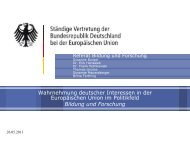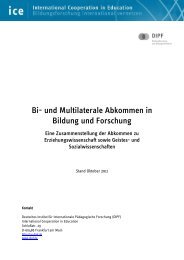tIif r - International Cooperation in Education - Deutsches Institut für ...
tIif r - International Cooperation in Education - Deutsches Institut für ...
tIif r - International Cooperation in Education - Deutsches Institut für ...
Create successful ePaper yourself
Turn your PDF publications into a flip-book with our unique Google optimized e-Paper software.
was supported by the further development of the author<strong>in</strong>g tool CBA Item Builder. These<br />
extensions <strong>in</strong>clude the MicroFIN and MicroDYN item types. The MicroDYN item type is used to<br />
build a simulation of a dynamic system consist<strong>in</strong>g of exogenous and endogenous variables and<br />
set l<strong>in</strong>ear structural equations (LSE) describ<strong>in</strong>g the <strong>in</strong>terdependencies of the variables. The<br />
MicroFIN type is used to build a simulation of a “f<strong>in</strong>ite state mach<strong>in</strong>e” consist<strong>in</strong>g of a f<strong>in</strong>ite<br />
number of states, transitions between states and actions. Another project is exam<strong>in</strong><strong>in</strong>g<br />
multidimensional adaptive test<strong>in</strong>g. 11<br />
School evaluation<br />
The DIPF has developed a set of modules for school evaluation. These questionnaires have been<br />
used by several hundred schools all over Germany dur<strong>in</strong>g the last six years. The evaluation<br />
projects are among the first large-scale standardised approaches to school evaluation <strong>in</strong><br />
Germany. More recently, the DIPF has become responsible for programme evaluation <strong>in</strong> the<br />
field of autonomous schools and <strong>in</strong> programmes for enhanced school democracy and all-day<br />
schools. With<strong>in</strong> those studies, the DIPF has ga<strong>in</strong>ed broad experience <strong>in</strong> design<strong>in</strong>g<br />
questionnaires for school evaluation and analys<strong>in</strong>g school effectiveness factors.<br />
<strong>International</strong> comparative research<br />
The DIPF was the lead agency <strong>in</strong> an <strong>in</strong>ternational project aimed at identify<strong>in</strong>g the education<br />
system factors as well as the cultural and economic factors responsible for <strong>in</strong>ternational<br />
variations <strong>in</strong> student performance. The project, which focussed on <strong>in</strong>tegrat<strong>in</strong>g f<strong>in</strong>d<strong>in</strong>gs from<br />
quantitative and qualitative cross-national educational research, was commissioned by the<br />
German Federal M<strong>in</strong>istry of <strong>Education</strong> and Research.<br />
Comprehensive surveys on the education systems <strong>in</strong> Canada, England, F<strong>in</strong>land, France,<br />
Germany, the Netherlands and Sweden, based on a common analytical framework, were<br />
<strong>in</strong>itially undertaken by national experts. The <strong>in</strong>ternational comparative research project then<br />
used these f<strong>in</strong>d<strong>in</strong>gs by l<strong>in</strong>k<strong>in</strong>g the results from PISA 2000 to qualitative evidence of important<br />
features of public policy. These features <strong>in</strong>cluded strategies for educational reform and<br />
<strong>in</strong>novation, issues of governance and resource allocation, national approaches to standardsett<strong>in</strong>g<br />
and to assessment and system monitor<strong>in</strong>g, the organisation of support systems, the<br />
professional development of teachers, and national approaches to address<strong>in</strong>g socio-economic<br />
differences <strong>in</strong> students‘ backgrounds.<br />
The results of the project were published <strong>in</strong> German and English. Key results from the<br />
multilateral study were used by the OECD to prepare the report “What makes school systems<br />
perform? See<strong>in</strong>g school systems through the prism of PISA” Paris, 2004.




![[PDF] Stiftungsverzeichnis - International Cooperation in Education ...](https://img.yumpu.com/7407068/1/184x260/pdf-stiftungsverzeichnis-international-cooperation-in-education-.jpg?quality=85)
